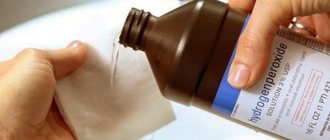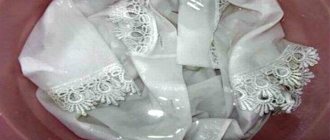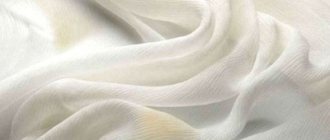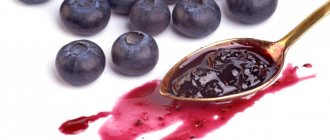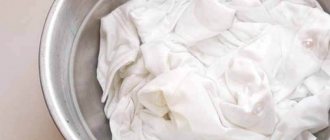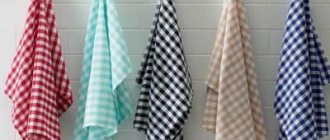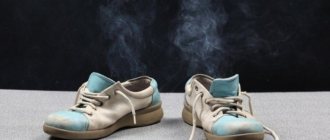Any housewife wants to achieve impeccable whiteness of clothes at home. The ability to keep tablecloths, school shirts, children's linen and kitchen towels perfectly clean is a rarity. Bleaching white clothes with hydrogen peroxide is a simple and effective way to achieve cleanliness, proven over the years.
Bleaching with hydrogen peroxide is an ancient way to achieve cleanliness.
Advantages and disadvantages of bleaching laundry with hydrogen peroxide
Benefits of bleaching white fabrics with hydrogen peroxide:
- low cost;
- removal of old plaque and yellowness;
- ease of use;
- preservation of the structure of the material;
- application for delicate fabrics;
- returning washed laundry to its original appearance;
- removing stains from deodorant, sweat and oil;
- availability of the drug.
The only downside to bleaching with hydrogen peroxide is the smell. Replace 1 tbsp. l. 3% peroxide can be 1 tablet of hydroperite. The effects of the drugs are the same.
Attention! The whitening effect is achieved by directly applying the product to the stain. The matter is saturated with oxygen, which breaks down the dirt.
Peroxide is a readily available antiseptic. The drug is sold in any pharmacy in the country. For bleaching, use a 3% peroxide solution. Usual composition concentration: 2 tbsp. l. drug per 10 liters of hot water.
We recommend reading: How to remove brilliant green from linoleum
Remove stains on jeans with soda
Denim should be cleaned of suspicious stains before washing - this is a fundamental point. If you do the opposite, you may find that the contamination has become almost hopeless for removal.
Removing stains with water is a bad option, especially if they are grease.
Some people try to remove greasy stains on jeans using strong store-bought products - the fabric fades and the item loses its presentation.
To remove a stain on jeans, begin by laying the pants out on a table or other flat surface and generously pouring NaHCO3 onto the stain.
The powder is rubbed into the dirt, leaving it in this state for several hours.
As auxiliary materials you need to use a white or light napkin.
Expert opinion
We recommend!
Rags made of colored fabric are not recommended - the colors can transfer to the jeans, aggravating the situation. The fresher the dirt, the easier it is to deal with.
Features of bleaching laundry with hydrogen peroxide
White clothes look noble. But maintaining her ideal appearance for as long as possible is quite difficult. Light-colored linen quickly washes out, acquires a yellow tint and loses its shine. The use of hydrogen peroxide to remove stains from fabrics is associated with some features:
- When restoring the material, do not mix dark and light underwear to avoid shedding.
- Old yellow stains from wool and silk are removed in several stages. Clothing is placed in a mixture of peroxide diluted with water. After 30 minutes, the product is drained, the laundry is washed and dried. If dirt remains, the procedure is carried out the required number of times until the color is restored.
- Removing yellow stains from cotton and linen is carried out by directly applying a peroxide solution to the material. If the yellowness remains, the procedure is repeated until the contamination disappears.
- Bleaching is carried out only once every 3-4 washes, otherwise the strength properties of the material will be lost.
- After bleaching, clothes are rinsed in 2 stages: first at a temperature of 20-40 ° C, and then in cold water.
Each type of matter has its own recipe for restoring whiteness. Therefore, when bleaching, things are separated not only by color, but also by type of fabric: synthetics, silk and wool, or cotton and linen.
First actions
Once the stain is set, wipe it off with a damp cloth or handkerchief. Be careful not to rub dirt deeper into the fibers.
Treat the fresh stain with dishwashing detergent.
What else can you do:
- Pour baking soda over the dirt;
- Apply dish gel to the greasy area;
- Place the dirty area under running cold water.
Heated glycerin will absorb dried dirt. Dampen the cloth and place it back in place.
How to bleach clothes with hydrogen peroxide
With repeated washings, the white item turns gray and dull. To restore the color saturation of the laundry, prepare a composition at the rate of ¼ cup of hydrogen peroxide per 5 liters of water at a temperature of up to 40 ° C. The laundry is left in the resulting mixture for 3 hours, then rinsed with the addition of vinegar or balm for delicate natural fabrics.
It is recommended to use a 3% peroxide solution when bleaching fabrics in the following ways:
- to get rid of old yellow stains, white clothes are soaked in the mixture for 1-2 hours;
- to avoid gray deposits on bedding, add 1/2 cup of hydrogen peroxide to the automatic machine when washing clothes;
- to restore the original color, white items are soaked in the solution for 1-3 hours;
- To whiten clothes from tea, coffee, wine, fruit, juice and blood, the composition is applied directly to the stain.
We recommend reading: The benefits of white wine and how to make it at home
How to bleach wool laundry with hydrogen peroxide
Stains on white clothes made from fabrics containing wool or silk are removed by hand washing. A solution to remove stains with hydrogen peroxide prepared from the following ingredients:
- 200 g table salt;
- 25 g of detergent for delicate fabrics;
- 10 liters of water at a temperature of up to 30 °C;
- 700 ml 3% peroxide.
Delicate items made of wool and silk are washed by hand at a temperature of 25-35 oC
Place white clothes in the prepared mixture for 3-5 hours. Then carefully remove the item using pressing movements. The product is not pulled out, but everything is taken out at once, pressing with both hands. Draw warm water up to 35 ° C and rinse the laundry well with conditioner for delicate fabrics. The washed clothes are carefully laid out on a horizontal surface covered with a terry towel.
Washing a down scarf:
To restore the whiteness of down products, add 2 tbsp to 10 liters of water at a temperature of 30-35 °C. l. peroxide and place a shawl or scarf in the resulting mixture for 20 minutes. After washing, the product is rinsed with the addition of vinegar and hair conditioner.
How to bleach synthetic items using hydrogen peroxide
White underwear made of thin synthetic material wears out and loses color over time. Bleaching bras and panties with hydrogen peroxide. To do this, soak underwear in the following composition:
- 10 liters of water at a temperature of 20-30 ° C are taken into the basin;
- diluted with 3 tbsp. 3% hydrogen peroxide stirring;
- soak white underwear in the prepared product for 1 hour;
- The laundry is placed in an automatic machine, washed in the usual way, rinsed with the additional rinse function and dried.
Advice! To bleach polyester lace underwear, use only granular powder or a product for delicate white fabrics.
Soaking white synthetic items in a prepared peroxide solution for 30 minutes before the main wash will remove the smell of sweat from your laundry.
How to bleach white linen and cotton items with hydrogen peroxide
White linen and cotton items are bleached with a 3% peroxide solution, placing it directly into the powder compartment of the automatic machine during washing. 15 ml of peroxide is added to the cell at a water temperature of 65 °C.
To bleach a T-shirt and knitwear, hydrogen peroxide is poured into a plastic basin or bucket with 2 liters of water at a temperature of 40-65 ° C and 1 tsp is added. peroxide. White T-shirts are placed in the resulting composition for 20 minutes. After this, the clothes are rinsed and dried.
If white knitted clothing has yellow spots, add 1 tsp to the resulting product. soda This will give the product a lost whiteness.
How to whiten white socks with hydrogen peroxide:
Bringing whiteness back to underwear
Underwear is usually made from delicate types of fabric, which means it requires special care. When working with it, we perform the following actions:
- We fill a basin with water at room temperature.
- Add 3 tablespoons of peroxide and stir.
- Soak the laundry for 30 minutes.
- We rinse the T-shirts and shorts well and send them to dry.
Tulle and organza can also be bleached with peroxide. To do this, they are soaked in water with the addition of a product, and then washed in the usual way.
How to enhance the effect of fabric bleaching with hydrogen peroxide
A hydrogen peroxide solution removes stains on cuffs and collars and restores the appearance of gray, worn clothes. The following drugs help enhance the bleaching effect of white fabrics:
- ammonia;
- soda ash;
- lemon juice or acid;
- laundry soap.
This composition is used only for washing white items. It is impossible to remove stains on colored fabrics with this product, since the combination of peroxide with other substances can lead to discoloration of the material.
Peroxide and ammonia for whitening
Ammonia will help get rid of gray plaque and yellowness on white fabrics and enhance the whitening effect. For this we recommend:
- Dilute 1 tbsp in 5 liters of water at a temperature of up to 40 °C. l. peroxide and 1 tbsp. l. ammonia.
- Dip white clothes into the resulting solution and leave to soak for 30-50 minutes.
- After the time has passed, snow-white items are rinsed twice and washed daily.
Whitening tulle with hydrogen peroxide is carried out with a composition of:
- 10 liters of water, temperature 40-65 oC;
- 2 tbsp. l. 3% peroxide;
- 1 tbsp. l. ammonia.
The tulle is placed in the resulting mixture, soaked for 5-10 minutes, and rinsed thoroughly with warm and cold water.
A solution of hydrogen peroxide and ammonia with water helps restore lost whiteness to things
To bleach a blouse or shirt, dilute 1 tbsp in 10 liters of water at a temperature of 40-70 °C. l. ammonia and 2 tbsp. l. 3% hydrogen peroxide solution. The laundry is dipped into the resulting composition for 20-30 minutes and rinsed thoroughly.
To ensure that cuffs and collars are washed perfectly, they are first rubbed with laundry soap. This enhances the whitening effect.
Hydrogen peroxide and baking soda for whitening clothes
A mixture of hydrogen peroxide and soda has an effect comparable in quality to professional bleach. To restore the whiteness of collars and cuffs, prepare a paste of 10 ml of peroxide and 1 tsp. soda The resulting composition is applied to the contaminated areas with a brush and left for 5-15 minutes. Then wash in an automatic machine with an additional rinse function.
We recommend reading: Baking soda: beneficial properties, uses, how to take
A paste made from hydrogen peroxide and baking soda whitens shirt cuffs and collars.
When bleaching children's whites and kitchen towels with a mixture of hydrogen peroxide and soda, excellent results are obtained. This mixture has proven itself well among housewives. Add 1 tsp to 2 liters of water at a temperature of 30 °C. peroxide and 1 tbsp. l. soda ash. White items are placed in the mixture for 10 minutes and washed as usual.
Cotton and linen white kitchen towels can be bleached using soda ash and peroxide, which are poured into the laundry detergent compartment. At a temperature of 60-70 oC, laundry is washed as usual. It is not recommended to use additional stain removers with this method.
Attention! Use baking soda and peroxide bleach only on cotton and linen fabrics. Before using the paste on things, the product is tested in an inconspicuous place of the product so as not to burn the material.
School white shirts cause a lot of trouble for housewives. Stubborn stains from sweat and deodorants, greasy food marks, marks from a ballpoint pen - all this must be removed from the child’s clothes. The following solution will help to bleach a blouse with hydrogen peroxide from sweat and yellow stains:
- 4 liters of water at a temperature of 40-70 ° C;
- 2 tbsp. l. soda ash;
- 2 tsp. peroxide.
A shirt or blouse is dipped into the resulting composition for 15 minutes. After the time has passed, the items are thoroughly rinsed and dried.
Stages of whitening a blouse using a solution of water, hydrogen peroxide and soda
Whitening with hydrogen peroxide and citric acid
A solution of lemon juice or acid and hydrogen peroxide can even cope with stains from fuel oil and diesel fuel on white things. To prepare the composition you will need:
- 2 liters of warm water;
- 1 tsp. peroxide;
- 1 tsp. citric acid.
White clothes with stains are soaked in the resulting mixture for 10-15 minutes, rinsed well and washed.
Synthetic fibers react well to citric acid, which helps to delicately deal with stains on white items. For this:
- Water at a temperature of up to 40 °C is filled into the basin.
- Add 1 tsp. hydrogen peroxide.
- Squeeze juice from ½ part lemon.
- Mix the composition thoroughly.
- Place clothes made of synthetic fabric for 20-30 minutes.
- Rinse things thoroughly, first at temperatures up to 40 ° C, and then in cold water.
The composition of citric acid and hydrogen peroxide gently whitens synthetic fabrics
The resulting solution eliminates yellowness on white blouses. To do this, apply the mixture to the areas of contamination with a sponge and leave for 30 minutes. If necessary, wash the entire item with this mixture.
Light jeans always have a problem bleaching. A composition of citric acid and hydrogen peroxide will cope with stains on things. To do this, mix 1 liter of water with 1 tsp. citric acid and 1 tbsp. l. hydrogen peroxide. White jeans are soaked for 20-30 minutes. Wash with the extra rinse function.
If desired, this product is applied from a spray bottle to the legs of colored jeans to lighten some areas.
To achieve a snow-white effect on synthetic fabrics, use the following composition:
- 5 liters of warm water;
- 1 tbsp. l. washing powder for delicate fabrics;
- 4 tbsp. l. table salt;
- 1 tbsp. l. hydrogen peroxide;
- 1 tbsp. l. ammonia.
Mix the ingredients well. White items made from synthetic fibers are immersed in the resulting solution for 2 hours. Rinse thoroughly 2 or more times.
Homemade stain remover for colored fabrics
For colored items, prepare a weak saline or soap solution. Test the fluid in an inconspicuous area to make sure the color has not changed.
The soap will remove the stain and help preserve the color of the clothing.
If the fabric has not faded or turned white, feel free to use the prepared stain remover.
Salt
A simple recipe will get rid of impurities of plant origin (grass, fruits, berries):
- Make a saline solution (a tablespoon of powder per glass of liquid).
- Apply to dirty area.
- Wait 20 minutes.
- Rinse and wash.
Soap
Before washing clothes, use laundry soap as a topical detergent. Use soap shavings to create an effective laundry detergent:
- Fill a liter saucepan with a tap and place on the fire.
- a quarter of soap for washing.
- Boil green tea in a glass.
- Add crushed soap to boiling water.
- Stir and wait until dissolved.
- Turn off the stove, add 100 g of soda ash to the infusion.
- Pour in green tea.
Precautions when bleaching clothes with hydrogen peroxide
When removing hydrogen peroxide stains on white things without protective equipment, you can get burned.
Burn on hand from hydrogen peroxide
There are precautions that must be followed:
- A paste of baking soda and hydrogen peroxide is applied to a white cloth for 10-15 minutes.
- Delicate items are soaked in warm water at a temperature of no more than 40 °C.
- Industrial bleaches are not added to hydrogen peroxide solutions. Combined use results in an undesirable chemical reaction, which may cause things to deteriorate or cause a fire.
- Rust stains on white clothes cannot be removed with peroxide.
- It is recommended to wear rubber gloves when mixing compounds to avoid getting burned.
- If the solution comes into contact with the eyes or mouth, a burn to the mucous membrane may occur. The affected areas are thoroughly washed with plenty of running water. If blisters begin to appear, immediately consult a doctor for qualified help.
- At home, it is not recommended to use a hydrogen peroxide solution of more than 3%.
- It is necessary to work with peroxide only in ventilated areas to avoid poisoning.
- In order not to spoil the clothes, first test the product on a piece of cloth or in an inconspicuous area.
Attention! Items should be completely immersed in the hydrogen peroxide solution. To avoid product color differences after surgery.
Top household chemicals in the fight against yellow spots
If you can’t remove the yellowness with home remedies, professional stain removers will do. Among them:
- ACE OXI MAGIC.
- Vanish OXI Action.
- Antipyatin.
- Frau Schmidt.
- Ecover.
- Amway Pre Wash.
- Sarma Active.
- Just a minute.
- Edelstar.
- Udalix Ultra.
To remove stains on white, it is recommended to use not only professional household chemicals, but also folk recipes.
What to do if things are stained. First measures
Any item of clothing can fade . Washing new wardrobe items, clothes made from bright fabrics, wool or denim can cause unwanted staining. Proper organization of washing and distribution of items helps reduce the risk of damage.
If such a situation occurs, do not panic.
The product can be saved if you immediately use proven methods:
- Boiling. Under the influence of high temperature, the paint is washed out of the fabric. This is one of the most effective methods, but it is not suitable for all types of fabric. Some materials may become deformed.
- Repeated washing . It is necessary to remove all things that can shed. It is better to wash the item of clothing separately. Active powder and the maximum temperature allowed by the tag on the clothing will help restore the original appearance of the products.
- Bleaching . This method is only suitable for white products.
Advice! It is important to act quickly and immediately after painting. Drying your clothes and ironing them will cause the dye to bond even more firmly into the fibers of the fabric. After this, it will be much more difficult or simply impossible to remove it.
Reviews from people
Elena, 35 years old
I had a favorite blouse - my mother gave it to me shortly before her death. I took care of it for many years, but then fashion returned. I only wore it once to an important event and it turned out that the fabric was saturated with the smell of sweat! Washing did not help at all, a friend suggested using baking soda powder. I diluted it with water to a thick cream, spread it on the underside of the blouse in the armpit area and soaked it overnight. In the morning I washed it by hand and dried it in the fresh air. No smell! This method is harmless to the skin, and therefore you can apply the mixture not only to clothes, but also to the armpits themselves.
Natalie, 20 years old
I have been seriously involved in sports for many years, I love white T-shirts, sneakers and tracksuits - they look cool. At this time, a lot of clothes had to be thrown away due to yellowness in the armpits, from which the most expensive powders could not help. I only recently learned how to use home remedies to combat this problem. I'm impressed - my favorite costumes have been saved!
Svetlana, 27 years old
I recently got married, and my husband only wears white shirts to work. Previously, his mother washed them, but now it is my responsibility. After a while, whitish stains appeared on the shirts, which had not happened before. My husband noticed and was very dissatisfied - he is the boss, he needs to conform. I had to turn to my mother-in-law for help. She laughed at my inexperience, but told me how to fix the problem with soda powder. The shirts became like new, peace reigned in the family.
Nikolay, 35 years old
For a bachelor, this is invaluable information. I sometimes use folk recipes from the Internet. NaHCO3 is power, I confirm as a professional chemist.
Rules to follow when removing contaminants
Before removing any formations on your own, you should familiarize yourself with the following tissue care rules:
- Dirt from thin fabrics is cleaned from the inside out;
- if the use of a certain stain remover can provoke a change in the color of a colored item, then it should be tested in an inconspicuous place;
- Don’t put off stain removal until later. This situation allows microelements to penetrate deeper into the tissue structure, which over time complicates their removal;
- Removing stains should begin with finding out the nature of the contamination on things. This can be done by appearance, color, smell or other characteristics;
- if you were unable to find out the nature of the origin of the stain, then first you should try more gentle products or universal stain removers;
- It is important to pay attention to the manufacturer’s recommendations for fabric care, which are indicated on the product label. The label contains instructions on how to wash, dry and iron the item, whether the material is suitable for dry cleaning or whether it is contraindicated;
- After removing the stain, the product must be rinsed with water or washed with washing powder.
- If the item cannot be washed, then the remaining stain remover is washed off by applying a cotton swab moistened with clean water.
Treatment of fabric with various solvents is called “dry cleaning,” that is, stains are removed without first soaking the item. Solvents are harmful, volatile and flammable substances. In dry cleaners, the use and storage of such materials takes place in special workshops that comply with technical safety standards. When using such solvents at home, you need to remember that:
- the use of such substances may harm the skin. Therefore, it is necessary to work with them with gloves, and after use you need to lubricate your hands with cream;
- cleaning should be carried out away from open fire and heating devices;
- Removal of contamination should be carried out in a well-ventilated area, since inhalation of large amounts of vapors of harmful substances can cause headaches and nausea.
